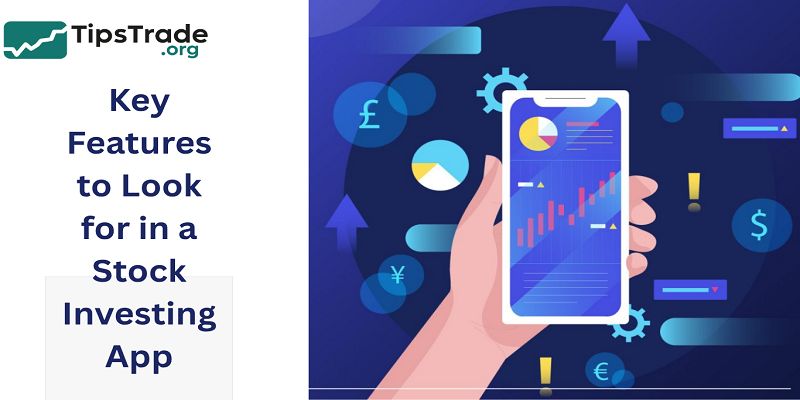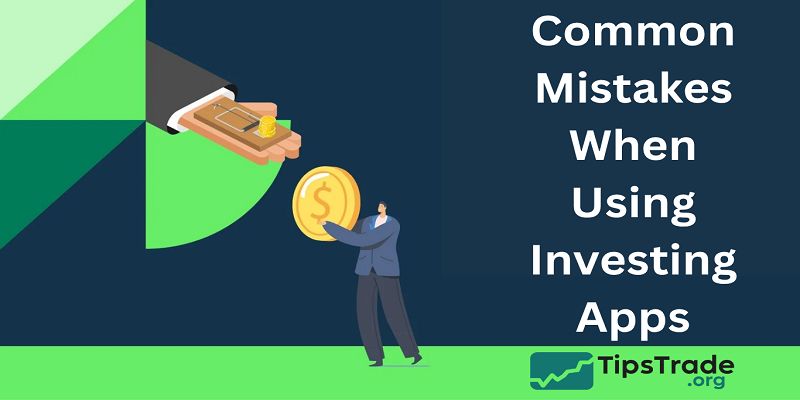Stock investing apps are digital platforms that allow users to buy, sell, and manage stocks conveniently from their mobile devices. These apps provide easy access to the stock market, real-time updates, lower fees, and greater control over investment decisions. By eliminating the need for traditional brokers, stock investing apps empower investors with fast transactions and personalized insights. Visit tipstrade.org and check out the article below for further information.
What Are Stock Investing Apps?

- A stock investing app is a digital platform that allows users to buy, sell, and manage investments directly from a mobile device.
- These apps connect users to financial markets, offering access to stocks, ETFs, mutual funds, options, and even cryptocurrencies.
The evolution of investing technology
- In the 1990s, online brokerage websites like E*TRADE and Charles Schwab started replacing traditional phone-based stock trading.
- The next wave came with the smartphone revolution. Apps like Robinhood (2013) and Acorns (2014) pioneered mobile-first investing — offering commission-free trading and intuitive interfaces.
Today, over 80% of retail investors use mobile apps for some or all of their trading activities (Statista, 2024).
Key benefits of investing apps
- Accessibility: Anyone can start investing with just a few dollars.
- Education: Many apps offer built-in tutorials and demo accounts.
- Convenience: Real-time updates, alerts, and portfolio tracking.
- Low fees: Most major apps have eliminated trading commissions.
- Automation: Some platforms offer robo-advisors or automatic investing.
These features make the financial markets more democratic, bridging the gap between Wall Street and everyday investors.
See more:
- Important Economic Indexes Every Trader Needs To Know
- How To Buy Stocks in 4 Steps: Quick-Start Guide for Beginners
- Long-Term Stock Investing: Benefits and Key Principles to Understand
- Day Trading Stocks: Benefits, Risks, and Effective Investing Strategies
How Stock Investing Apps Work
Account setup and verification
- Most apps require you to register with personal details, verify your identity (KYC), and link a bank account.
- Once approved, you can deposit funds and begin trading immediately.
- Some platforms like SoFi Invest or Fidelity even allow instant deposits, letting you start investing before the transfer clears.
Trading and execution
- When you place an order — say, to buy Apple stock — the app routes your trade to an exchange or a market maker.
- Depending on the platform, you might choose between market orders, limit orders, or stop-loss orders.
- Apps like Webull and Interactive Brokers give you advanced trading tools with real-time data, while others like Robinhood focus on simplicity.
Fractional shares and recurring investing
- Fractional investing lets you buy a piece of a stock, not a whole share. For example, you can invest $10 in Amazon even if one share costs $3,000.
- Many apps also support recurring investments, helping users follow a dollar-cost averaging strategy automatically.
The Pros and Cons of Using Stock Investing Apps

Advantages
- Low or No Fees: Most leading apps (e.g., Robinhood, eToro, SoFi) charge $0 commissions.
- Ease of Use: Simple, modern interfaces make investing approachable.
- Educational Resources: Platforms like Fidelity and TD Ameritrade include research reports and tutorials.
- Accessibility: You can invest anywhere, anytime.
- Portfolio Diversification: Many apps allow access to global markets and ETFs.
Drawbacks
- Overtrading Temptation: Easy access can lead to impulsive decisions.
- Limited Research Tools: Simpler apps may lack deep analytics.
- Hidden Costs: Beware of spreads, currency conversion fees, or margin rates.
- Security Risks: Not all apps are regulated or insured.
- Data Privacy: Some free apps may monetize user trading data.
Understanding both sides helps investors pick tools aligned with their goals and experience level.
Key Features to Look for in a Stock Investing App

When choosing an investing app, prioritize safety, usability, and transparency. Below are the most important factors to evaluate.
Regulation and Security
Always confirm if the platform is regulated by reputable authorities such as:
- SEC / FINRA (U.S.)
- FCA (U.K.)
- ASIC (Australia)
- CySEC (Europe)
Security features like two-factor authentication (2FA), SSL encryption, and SIPC insurance (for U.S. investors) are must-haves.
Apps that guarantee profits or operate from offshore jurisdictions without regulation should be avoided.
Cost Transparency
Even “zero-commission” brokers make money. Check for:
- Spreads between buy/sell prices
- Margin loan interest
- Account maintenance or withdrawal fees
- Currency conversion costs
For example, Interactive Brokers (IBKR) has low trading costs but charges based on account activity tiers.
Usability and Learning Support
A clean interface makes investing intuitive. Look for:
- Clear portfolio overview
- Watchlists and price alerts
- Demo or paper trading accounts
- Integrated learning modules
Apps like Public and SoFi excel here, blending social learning with real investing.
Asset Coverage
Some apps only support U.S. stocks, while others let you access global markets. Consider whether you want exposure to:
- International equities (e.g., via IBKR or eToro)
- ETFs and index funds
- Options, crypto, or bonds
More choice can mean more diversification, but complexity should match your skill level.
Best Stock Investing Apps in 2025
Here’s a comprehensive look at the top-performing apps for different investor types.Robinhood – Best for Simplicity
| App | Best For | Core Features | Fees | Regulation |
| Robinhood | Beginners | Commission-free, fractional shares | $0 | FINRA, SIPC |
| Webull | Active traders | Advanced charting, technical tools | $0 | FINRA |
| SoFi Invest | Young investors | Robo-advisor, crypto, auto-invest | $0–$5 | SEC |
| Fidelity Investments | Long-term planners | Research, retirement tools | $0 | SEC, FINRA |
| eToro | Global social investors | CopyTrading, multi-asset | Spread-based | FCA, CySEC |
| Interactive Brokers | Professionals | 150+ markets, margin trading | Tiered | SEC, FCA |
| Charles Schwab | U.S. investors | Mutual funds, IRAs, advice | $0 | FINRA |
| Acorns | Passive savers | Micro-investing, round-up savings | $3–$9/month | SEC |
Robinhood made investing accessible for millions. Its user-friendly app and zero-commission policy set the industry standard. However, critics note its lack of advanced research tools and occasional trading halts during market volatility.
Fidelity – Best for Retirement and Research
- Fidelity offers both mobile convenience and institutional-level research. Its integration with 401(k) and IRA accounts makes it a complete financial hub for serious long-term investors.
eToro – Best for Social Trading
- With over 30 million users globally, eToro’s CopyTrading system lets beginners replicate professional strategies.
- However, investors should use it wisely — blindly copying traders can lead to unnecessary risks.
Interactive Brokers – Best for Global Access
- IBKR remains the go-to platform for professionals and global investors.
- Its coverage of 150+ markets, low currency fees, and advanced order types make it unmatched in scope, though beginners may find it intimidating.
SoFi Invest – Best for All-in-One Financial Management
- SoFi integrates investing, loans, and savings in one app.
- Its automatic investing and financial planning tools appeal to young professionals aiming to build wealth efficiently.
Common Mistakes When Using Investing Apps

Even with top apps, many investors fall into predictable traps. Here are some examples — and how to avoid them.
Overconfidence and Emotional Trading
- Easy access can cause FOMO (Fear of Missing Out). Many users trade excessively during volatile periods, leading to losses.
- Use alerts and stick to your strategy instead of reacting emotionally.
Neglecting Diversification
- Investors often over-concentrate in popular stocks like Tesla or Nvidia.
- Diversify using ETFs or index funds to reduce risk exposure.
Ignoring Hidden Fees
- Currency conversions, premium research subscriptions, or margin interest can quietly reduce profits.
- Always check your annual cost percentage (ACP) or expense ratio.
Using Unregulated Apps
- Scam apps promise unrealistic profits.
- Always verify regulation status on official authority websites like FINRA BrokerCheck or FCA Register.
Lack of Financial Education
- Technology simplifies execution but not decision-making. Supplement your app use with educational resources — many platforms like TD Ameritrade offer free video courses.
Security, Privacy, and Trust
Investing apps handle sensitive personal and financial data. That’s why trustworthiness is critical to E-E-A-T compliance.
- Data protection: Look for SSL encryption and no data-selling policies.
- Fund protection: Ensure SIPC or FDIC insurance for U.S. brokers.
- Transparency: Reputable apps disclose business models (e.g., Robinhood’s PFOF structure).
- Reputation: Read user reviews on Google Play or Apple Store, but filter out fake feedback.
A legitimate app prioritizes investor protection over aggressive marketing.
The Future of Stock Investing Apps

AI and Personalization
- By 2025, most investing apps use AI for portfolio insights, risk analysis, and personalized recommendations.
- Apps like Wealthfront use algorithms to automate tax-loss harvesting and rebalancing.
Social and Community Investing
- Younger investors prefer learning through communities.
- Platforms such as eToro or Public merge social networking with investing, making it easier to share knowledge — though it also introduces herd behavior risks.
Sustainability and ESG Investing
- A growing trend is the inclusion of ESG (Environmental, Social, Governance) data.
- Apps like Fidelity and Betterment now let users screen investments based on sustainability metrics
Conclusion
Stock investing apps have revolutionized the way people invest by making the stock market more accessible and user-friendly. Their convenience and low costs attract both beginners and experienced investors alike. Overall, these apps offer a practical and efficient way to build and manage investment portfolios, supporting greater financial independence and informed decision-making.
>>See more:

